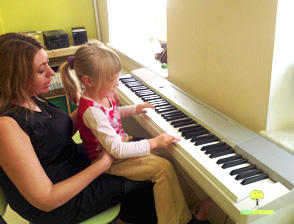What is this?
A system of individual musical sessions aimed at developing speech; communication skills; the hearing and rhythmical systems of a child.
What problems does this help solve?
Music and speech have a lot of similarities. They are built upon sound, rhythm and movement. Even the doctors of the medieval times have noticed that music is an effective method for correcting speech disorders. Modern neurological research shows that playing music is a unique form of activity that activates the maximum number of brain areas and teaches them to work in unison. For this reason it is not surprising that many children come to speak through the use of musical therapy sessions.
In our centre musical sessions are also used to help get rid of stammering.
How are the sessions conducted?
The composition of the sessions depends on the purpose of the course. For example, in the event that a child needs help developing communication skills and activating speech, the child will be offered various methods for interacting with an adult through musical activity, i.e. vocal improvisation, movement and games with music on the background or playing piano or drums with an adult.

he unique aspect of these sessions is that an adult doesn’t teach, but rather offers the child a choice of musical activity and follows the child’s initiative. In other words, the adult is engaging the child in a dialogue, which helps to not only develop musical abilities, but also to have fun by communicating through speech.
During the course of developing smoothness of speech (in the case of stammering) the speech therapist combined various methods aimed at developing sensory integration, sense of rhythm, breathing and vocal exercises. An effective method for treating stammering is a combination of musical therapy sessions and exercises with the use of Interactive Metronome.
Sessions are conducted by a music teacher and an art therapist.
Children starting from the age of 2 can take part in these sessions.
Sessions take place 1 to 2 times per week.

